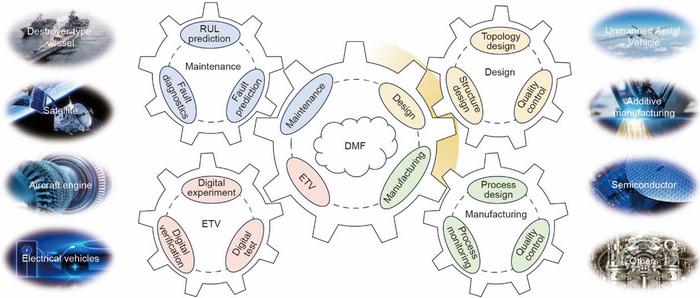In the swiftly shifting terrain of modern manufacturing and digital engineering, an innovative technology called Data-Model Fusion (DMF) is carving out a pivotal role. This multifaceted approach, recently examined in a comprehensive review published in the journal Engineering, marries the strengths of traditional model-based methods with cutting-edge data-driven techniques. Through this fusion, DMF promises to revolutionize how industries optimize processes, predict equipment performance, and innovate product designs, heralding a new era in smart manufacturing.
At the core of intelligent manufacturing lies the challenge of effectively utilizing vast quantities of data generated from sensors, machines, and production lines. Historically, model-based methods have provided engineers with the ability to leverage known physical laws and domain expertise to simulate and control manufacturing processes. However, these methods often come with significant computational demands and constraints in accuracy due to simplifying assumptions. On the other hand, data-driven approaches harness statistical learning and artificial intelligence to glean insights directly from operational data, but they can suffer from a lack of transparency and overfitting. DMF emerges as a powerful paradigm to integrate these two approaches, capitalizing on their complementary capabilities.
Data-Model Fusion operates across four stratified levels of integration: data-level, feature-level, method-level, and decision-level fusion. At the data level, raw information from sensors and simulations can be combined, enriching the dataset offered to predictive models. Feature-level fusion involves extracting and unifying relevant attributes from both physical models and raw data, enhancing the quality of the inputs for subsequent processing. Method-level fusion takes a step further by blending algorithmic techniques—such as coupling physics-based solvers with machine learning algorithms—to jointly tackle complex problems. Finally, decision-level fusion synthesizes outputs from multiple models, enabling robust and interpretable decision-making. This hierarchical structure reflects a nuanced approach to melding theoretical knowledge with empirical observations across the entire manufacturing value chain.
A conceptual framework outlined in the paper highlights the interconnected components essential for successful DMF deployment. Central to this framework are data-driven and model-based methods operating in tandem, connected via intelligent fusion strategies. These are supported by service architectures that facilitate integration into manufacturing systems and support dynamic feedback loops. Such a framework not only clarifies the objectives—like improved prediction accuracy or faster computational performance—but also establishes the constraints and boundary conditions that practitioners must navigate to achieve optimal synergy between heterogeneous data sources and models.
DMF’s practical applications span the entire product lifecycle. In the design phase, it enables engineers to optimize parameters with greater precision and reduced reliance on costly, time-consuming simulations. By integrating data-driven insights into design models, DMF reduces computational overhead and accelerates innovation cycles. Moving into manufacturing, DMF supports advanced process control strategies, leveraging real-time data and predictive models to enhance efficiency and minimize defects. This integration is particularly vital for complex, multi-stage manufacturing where dynamic adaptation can yield significant resource savings.
During experimentation, testing, and verification (ETV) stages, DMF plays a transformative role by incorporating surrogate models that approximate expensive computational simulations without sacrificing accuracy. This hybrid modeling approach dramatically cuts down the time required for validation while maintaining confidence in system performance. Furthermore, in maintenance operations, DMF enhances predictive maintenance by improving the interpretability of data-driven models through incorporation of domain knowledge. This facilitates more accurate Remaining Useful Life (RUL) predictions, enabling proactive interventions that reduce downtime and optimize lifecycle costs.
Looking forward, the evolution of DMF is being propelled by advancements in multidisciplinary domains such as digital engineering and digital twins. By creating comprehensive digital replicas of physical systems enriched with real-time data, these paradigms provide fertile ground for further integration of DMF methods. This comprehensive information space enables more precise modeling of complex manufacturing environments, resulting in smarter decision-making frameworks that can adapt dynamically to changing operational conditions.
Emerging technological developments are also set to accelerate DMF adoption. Large language models (LLMs), traditionally used for natural language processing, are now being adapted to interpret and generate technical insights, assisting in knowledge extraction and model refinement. Moreover, cloud-edge-end collaborative architectures promise to distribute computational loads intelligently across different nodes in manufacturing environments. This not only reduces latency and computational costs but also enhances privacy and security by localizing sensitive processing when needed.
Beyond core manufacturing processes, DMF is poised to revolutionize manufacturing service collaboration and virtual testing environments. By fostering seamless integration among stakeholders via shared digital platforms, manufacturing ecosystems can become more agile, responsive, and efficient. Virtual testing, powered by DMF, facilitates rapid prototyping and what-if analyses without necessitating costly physical trials, thereby streamlining innovation pipelines and reducing waste.
The promise of DMF extends beyond mere technical enhancement; it is fundamentally reshaping the conceptual landscape of manufacturing and engineering. By breaking down silos between physics-based understanding and empirical data science, DMF ensures that interpretability, accuracy, and computational efficiency coexist. As research in this field intensifies, and industrial adoption expands, the boundaries of what can be achieved in smart manufacturing and digital engineering will be profoundly extended.
In conclusion, Data-Model Fusion represents a significant leap toward realizing fully intelligent manufacturing systems that harmoniously blend domain expertise and data analytics. Its layered integration strategy offers a versatile toolkit for addressing long-standing challenges and unleashing new opportunities across product design, manufacturing operations, and maintenance. With support from burgeoning technologies and theoretical advancements, DMF is not only a promising research frontier but a tangible catalyst for industrial transformation in the years ahead.
Subject of Research: Data-Model Fusion for Smart Manufacturing and Digital Engineering
Article Title: Data–model Fusion Methods and Applications toward Smart Manufacturing and Digital Engineering
News Publication Date: 28-Jan-2025
Web References: https://doi.org/10.1016/j.eng.2024.12.034
Image Credits: Fei Tao et al.
Keywords
Smart manufacturing, Digital engineering, Data-model fusion, Predictive maintenance, Remaining useful life prediction, Digital twins, Process control, Surrogate models, Hybrid modeling, Large language models, Cloud-edge-end collaboration




